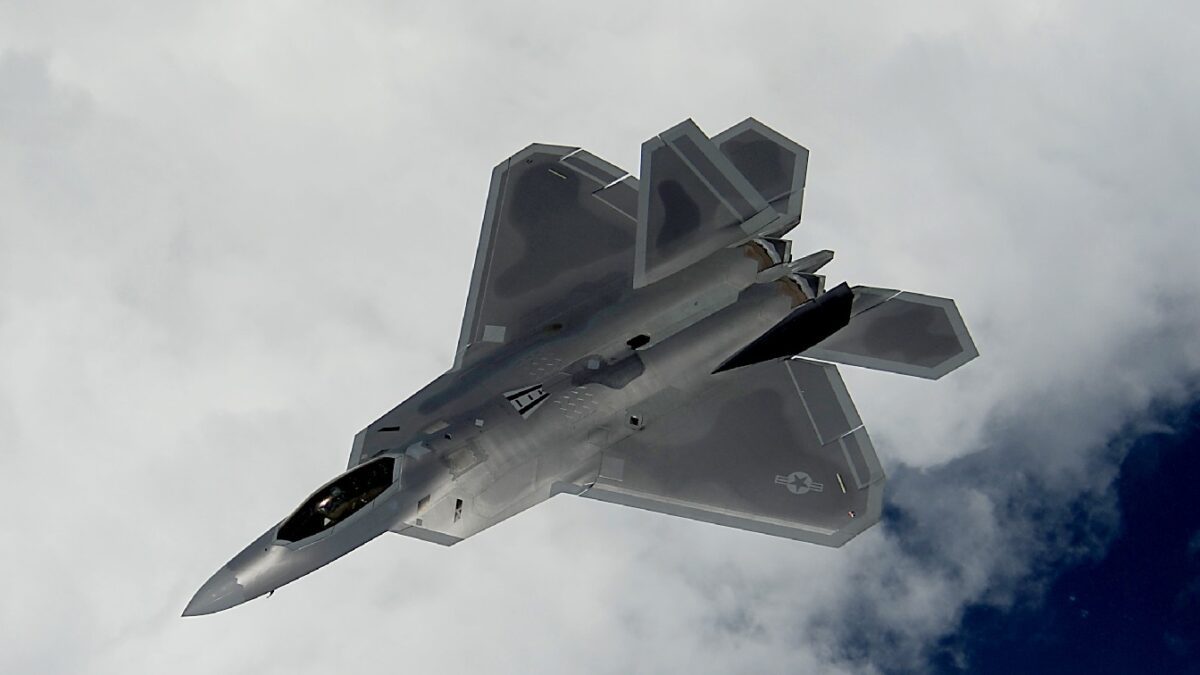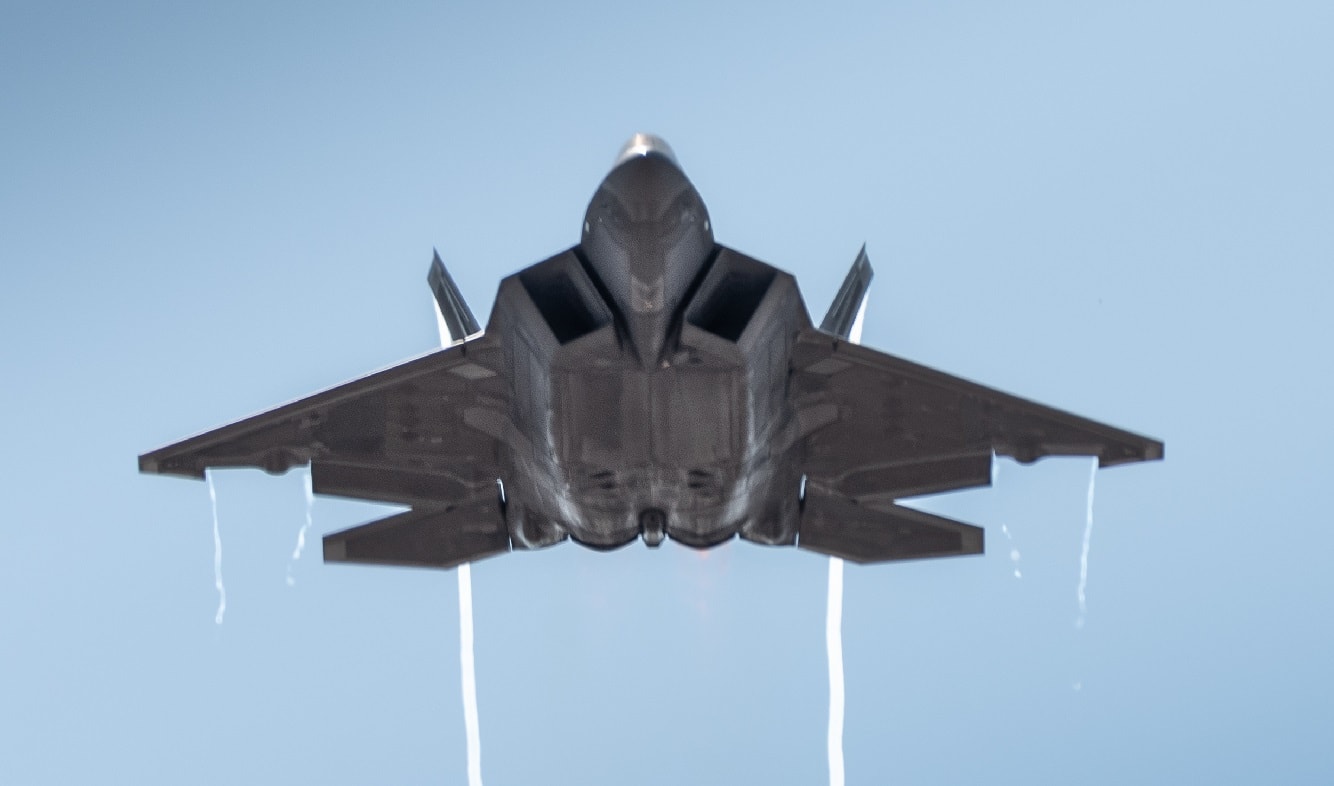The F-22 is, without a doubt, one of the best fighter aircraft to ever fly in the sky. With excellent stealth capabilities, the only problem the U.S. Air Force has with this fighter is that there is not enough of them to go around. We asked one of our top experts to explain all he knows about this fighter jet that China and Russia hate:
The F-22 Raptor according to many experts is the best fighter jet on the planet today. Here is the story of how the plane came into being.
Why the F-22 Raptor Was Created: It was the mid-1990s and the U.S. Air Force was at a crossroads regarding its fighter program. The Cold War was long over so Russia was not seen as an immediate threat. The Air Force had shown off its prowess in Operation Desert Storm with shock and awe precision-guided munitions. The stealth F-117 flew 1,271 sorties over Iraq with nearly a 100 percent success rate while suffering no losses. The F-15C had scored 34 out of 37 dogfighting victories against Iraq. But what was the next mission? South Korea was always a hotspot. The Balkans were on fire and the Americans flew bombing missions over Bosnia. The Air Force was also enforcing no-fly zones over Iraq to protect the Kurds from the Iraqi Army.
What Was the Next Step for the Air Force?
Military strategists and battle planners and were at a loss on what the future would hold. There were defense budget and personnel cuts because of the “peace dividend” in which the U.S. military was trimmed down after the Cold War. Money and resources were tight.
Laundry List of Needed Capabilities
These events and limitations gave the Air Force pause. What would the next fifth-generation fighter be to replace the F-15? It would need to be stealth like the F-117, but the Nighthawk was more for ground strikes than for dogfighting. Speed and maneuverability were a must. Supercruise mode, or the ability to fly at high speeds without afterburners, was preferred. Air superiority in multiple roles was a requirement. This meant dominant air-to-air and air-to-ground strike capabilities. A robust and diverse group of weapons in internal weapons bays would be a necessity.
Grueling Competition to Produce the Answer
Fortunately, the Air Force already had something cooking. There was a competition between the YF-22 and YF-23 prototypes for the future Raptor. This duel of competing airframes could someday require 750 airplanes to be purchased, so the stakes were high for Northrop-McDonnell Douglas and Lockheed-Boeing-General Dynamics. Northrop made two YF-23s and had an unforgettable design with a pushed-forward cockpit and a V-shaped tail. Alternatively, the Lockheed YF-22 had thrust vectoring technology with better maneuverability.
The YF-22 Had the Right Stuff
The YF-22 really pushed it during testing by launching missiles, operating at high angles of attack, and accomplishing high-G maneuvers. Northrop was more reserved and cautious during the tests and the YF-23 did not impress the evaluators as much. Ultimately the YF-22 was chosen.
F-22 Needed to Excel in a Difficult Time
Engineering and manufacturing of what would become the F-22 started in 1991. The first flight of the development version of the airplane began in 1997. This coincided with the tumultuous international security era after the Cold War and Operation Desert Storm. The Balkans crises were not over. This area of operations would still require the Air Force to lead the way in the 1999 NATO bombing campaign against the Serbs to defend Kosovo.
9/11 Created the War in Afghanistan and Iraq
The development of the F-22 could not come at a better time. Air Force acquisition leaders approved the Low-Rate Initial Production of the F-22 in 2001 – just in time for the Global War on Terror. The first initial production model came out in 2003. Then the Initial Operational Capability was met in 2005 and the F-22 entered service. Contractors produced 187 F-22s and the Air Force took the last one in 2012. The F-22 was never exported. In 2014, the Raptor entered combat over Syria in efforts against the Islamic State.
Meets Expectations
The F-22 met all the items on the wish list: a high level of stealthiness, supercruise, thrust vectoring for great maneuverability, and impressive avionics. This made the F-22 a true fifth-generation fighter perfect for dogfighting. Pilots lauded its “nimble” flight characteristics and “phenomenal” flight controls.
Plenty of Weapons
The F-22 comes equipped with two AIM-9 Sidewinder heat-seeking air-to-air missiles and six AIM-120 AMRAAM radar-guided missiles. For air-to-ground missions, the F-22 carries two 1,000-pound GBU-32 JDAMs or eight 250-pound Small Diameter Bombs. These all fit into its three internal weapons bays.
Powerful Engines
Two Pratt & Whitney F119-PW-100 turbofan engines make the airplane speedy with the ability to fly at MACH 2-plus. It has a ceiling of 50,000 feet and a range of 1,900 miles.
Just How Much Did It Cost?
Unfortunately, the Raptor came in over budget. Media watchdogs had trouble calculating just how much the F-22 cost the Air Force. Wired magazine asked how much in 2011. “As little as $137 million per jet and as much as $678 million, depending on how and what you count. The thing is, the best way of calculating the F-22’s cost may be the most abstract. But any way you crunch the numbers, the world’s best dogfighter has also been one of the most expensive operational warplanes ever.” The Air Force said it costs $143 million each.
It Had Its Downsides
The F-22 was criticized for not having the combat experience that other American fighters had achieved. All those capabilities did not translate into dogfighting. The technology created high costs in maintenance and sustainment. Only about half the fleet is available at any given time. The software proved difficult to update. It can’t carry external fuel tanks without compromising stealth. So, the shorter range would require in-air re-fueling while operating in the Indo-Pacific. China would be able to track the re-fueling activity. It also does not integrate well with the F-35.
What the Experts Think
“The F-22 Raptor, at least in my view, is the best fighter jet on the planet today,” explained a retired U.S. Air Force pilot who has flown the F-22 and many other fighter jets. “There is no plane on the planet today that can match the capabilities of the F-22. Russia, China – no nation today has anything like it. While she was designed decades ago, the F-22 is still better than anything else flying.”

A 1st Fighter Wing’s F-22 Raptor from Joint Base Langley-Eustis, Va., pulls away and flies beside a KC-135 Stratotanker with the 756th Air Refueling Squadron, Joint Base Andrews Naval Air Facility, Md., while his wingman refuels off the east coast, July 10, 2012. The first Raptor assigned to the Wing arrived, Jan. 7, 2005. This aircraft was allocated as a trainer, and was docked in a hanger for maintenance personnel to familiarize themselves with its complex systems. The second Raptor, designated for flying operations, arrived, Jan. 18, 2005. On Dec. 15, 2005, Air Combat Command commander, along with the 1st FW commander, announced the 27th Fighter Squadron as fully operational capable to fly, fight and win with the F-22.
Not Part of Future Plans, But It Should Be
In 2021, the Chief of Staff of the US Air Force, General CQ Brown, did not include the F-22 in his vision for the future Air Force. I don’t agree with General Brown. The F-22 is a great airplane. Yes, it was expensive to develop. It’s finicky and difficult to maintain. The range is not what it needs to be, but this thing is a Ferrari. It’s needed, especially with the possibility of a two-front war against Russia and China. It makes sense to keep the program going until it is replaced by the Next-Generation Air Dominance fighter. Its advantages outweigh its disadvantages. Keep a squadron in Guam as long as possible and the Air Force will not be disappointed.
The F-22 assuredly has a future role in 21st-century warfare.
Now serving as 1945s New Defense and National Security Editor, Brent M. Eastwood, PhD, is the author of Humans, Machines, and Data: Future Trends in Warfare. He is an Emerging Threats expert and former U.S. Army Infantry officer.

